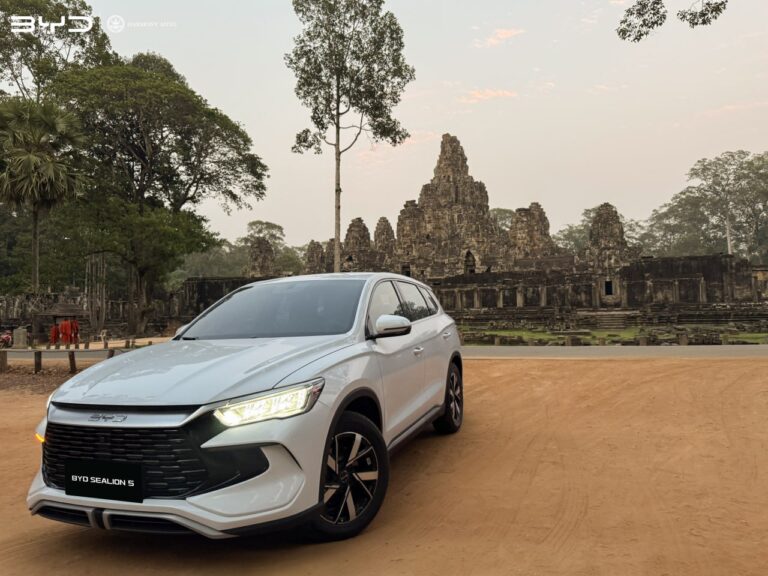Navigating the Future: EV Transport Challenges & Opportunities in Cambodia

Navigating the Future: EV Transport Challenges & Opportunities in Cambodia
The global automotive landscape is undeniably shifting towards electrification, and Cambodia is no exception. As a nation experiencing rapid economic development and a growing focus on sustainable solutions, the transition to EV transport in Cambodia is becoming a crucial element of its future. However, this promising journey, like any significant transformation, is paved with both considerable EV transport challenges in Cambodia and compelling Cambodia EV opportunities.
This article aims to provide a comprehensive look at the road ahead. We will dissect the primary hurdles that currently temper the widespread adoption of electric vehicles across the Kingdom. Simultaneously, we will shed light on the strategic advantages, the strong government commitment, and the collaborative efforts from both local and international partners that are actively paving the way for a truly green future for EVs in Cambodia. Understanding this intricate balance of challenges and opportunities is key to unlocking Cambodia’s full potential in sustainable mobility.
- Navigating the Future: EV Transport Challenges & Opportunities in Cambodia
- 1. Cambodia’s EV Vision: Accelerating Towards a Green Horizon
- 2. Navigating the Roadblocks: Key Challenges for EV Transport in Cambodia
- 3. Paving the Path Forward: Strategic Opportunities in Cambodia’s EV Landscape
- 4. The Leapfrog Opportunity: Cambodia’s Unique Path to a Green EV Future
- Conclusion: Charting a Sustainable Course for EV Transport in Cambodia
- Frequently Asked Questions (FAQs) About EV Transport in Cambodia
1. Cambodia’s EV Vision: Accelerating Towards a Green Horizon
Despite being a relatively nascent market, EV adoption in Cambodia is demonstrating remarkable momentum. The sight of electric motorcycles and cars on Cambodian roads is becoming increasingly common, signaling a clear shift in consumer preference and a growing awareness of the benefits of electric mobility.
Official figures highlight this nascent but significant acceleration. By October 2024, Cambodia had already registered an impressive 4,320 electric vehicles, comprising 2,513 cars, 478 three-wheelers, and 1,329 two-wheelers. The growth rates are particularly striking: personal electric car registrations surged by an astounding 710% and two-wheelers by 307% from October 2023 to October 2024. This EV adoption in Cambodia signifies a genuine enthusiasm for cleaner transport.
Underpinning this growth is the Royal Government of Cambodia’s ambitious vision. The nation aims for 70% electric motorcycles and 40% electric cars and urban buses by 2050 as part of its carbon neutrality targets. More immediate goals outlined in the National Policy on EV Development 2024-2030 are equally bold: targeting 30,000 EVs (including 25,000 passenger vehicles and 5,000 commercial vehicles), 720,000 e-motorcycles, and 20,000 e-tuk-tuks by 2030. This comprehensive policy involves 11 ministries and 53 policy measures, underscoring a unified national commitment to a green transport future.
2. Navigating the Roadblocks: Key Challenges for EV Transport in Cambodia
While the vision is clear, the path to a fully electrified transport system in Cambodia is not without its hurdles. Several EV transport challenges in Cambodia require strategic attention and collaborative solutions.
Firstly, charging infrastructure remains a primary concern. As of early 2025, there are only around 21-27 public charging stations nationwide, largely concentrated in urban centers like Phnom Penh. Rural areas suffer from a significant scarcity, leading to “range anxiety” among potential EV owners. Future projections are daunting, estimating a need for 9,900-33,800 charging points by 2050, requiring an investment of $168M-$576M. The lack of an official charging network policy framework and standardized equipment also poses challenges for reliability and user experience.
Secondly, the high upfront costs of EVs compared to traditional used internal combustion engine (ICE) vehicles—which dominate Cambodia’s market—act as a significant deterrent. While import duties for pure EVs have been reduced (from 30% to 10%), concerns persist regarding high road tax for EVs and an increased special tax on lithium batteries (10%), which some argue could nullify the benefits. The prevalence of untaxed grey market vehicles further complicates fair competition.
Thirdly, battery management and longevity present challenges. Consumers express concerns over battery degradation, lifespan, and potential damage from Cambodia’s tropical climate. Crucially, the country currently lacks robust facilities and regulations for the end-of-life disposal and recycling of EV batteries. By 2050, Cambodia could face decommissioning 0.7-2.5 GWh of batteries annually, highlighting an urgent need for sustainable recycling solutions.
Fourthly, public awareness and acceptance need to be significantly boosted. Many Cambodians are still accustomed to fuel-powered vehicles, and there’s a general lack of comprehensive public awareness campaigns to educate them on the benefits and practicality of EVs. This contributes to range anxiety and a preference for cheaper, used ICE vehicles.
Lastly, a significant skills gap exists. There’s a shortage of trained EV mechanics, engineers, and charging station technicians. This impacts maintenance costs and the availability of reliable repair services, posing a barrier to widespread adoption. Furthermore, regulatory gaps concerning land allocation, zoning, and permits for charging stations, along with the need for stricter standards for imported EVs, require immediate attention to prevent Cambodia from becoming a dumping ground for low-quality vehicles.
3. Paving the Path Forward: Strategic Opportunities in Cambodia’s EV Landscape
Despite the challenges, Cambodia’s EV landscape is brimming with Cambodia EV opportunities that could catalyze its transition to a green transport future. These opportunities are anchored in a combination of strong government commitment, market dynamics, and strategic partnerships.
First, the robust government commitment serves as a powerful catalyst. The National Policy on EV Development 2024-2030 is not just a document; it’s a living roadmap designed to attract investment and foster an enabling environment. Existing tax incentives, such as the reduced special tax on EV imports, demonstrate a tangible commitment to making EVs more accessible.
Second, the burgeoning market and receptive user base present immense potential. The exponential growth in EV registrations, coupled with Cambodia’s young and tech-savvy demographic (over two-thirds of the population is under 30), creates fertile ground for rapid adoption. Users are increasingly recognizing the long-term operational cost savings—estimates suggest potential annual savings of $133 for e-motorcycles and $1,069 for e-cars—making EVs a compelling economic choice over time.
Third, the synergy with Cambodia’s renewable energy sector is a game-changer. The nation’s high share of clean hydropower and rapidly expanding solar capacity mean that EV charging can be inherently green, offering a genuine zero-emission solution. This clean energy backbone also attracts significant green transport investment in Cambodia. International financial institutions like the IFC, in collaboration with local banks like ACLEDA and the National Bank of Cambodia, are actively pushing for green finance to unlock the estimated $36 billion needed for Cambodia’s climate goals by 2050.
Fourth, significant private sector investment and collaboration are already taking shape. The groundbreaking of a BYD assembly plant in Sihanoukville, expected by November 2025, is a testament to the immense confidence international players have in Cambodia’s EV potential. This fosters local manufacturing and job creation. Crucial public-private partnerships (PPPs) are also emerging as a key model for accelerating infrastructure development and skill-building initiatives. Industry leaders remain highly optimistic about the future of the EV market in Cambodia.
Finally, robust international support from organizations like the World Bank, UNDP, IFC, and bilateral partners such as Australia and Japan provides invaluable technical assistance, funding, and policy recommendations. This global collaboration allows Cambodia to learn from the successes and challenges faced by other nations, refining its own strategy. These collective efforts promise not only economic diversification but also substantial reductions in urban air pollution and the promotion of sustainable urbanization.
4. The Leapfrog Opportunity: Cambodia’s Unique Path to a Green EV Future
The confluence of existing challenges and burgeoning opportunities places Cambodia at a unique crossroads, offering a compelling “leapfrog” opportunity. Rather than painstakingly following the traditional, fossil fuel-intensive development path taken by many industrialized nations, Cambodia has the chance to bypass several stages and jump directly into a green, electrified transport future.
This strategic advantage is amplified by leveraging Cambodia’s inherent strengths: a youthful, adaptable workforce eager for new technologies; a strong governmental will underscored by comprehensive national policies; and an increasingly clean energy grid. An integrated approach, harmonizing policy, infrastructure development, technological adoption, and public engagement, is paramount. As a sustainable development expert at UNDP Cambodia aptly puts it, “Cambodia isn’t just adopting EVs; it has the potential to leapfrog traditional development paradigms, creating a truly integrated green transport and energy ecosystem. This requires bold vision and collaborative action from all stakeholders.” By consciously charting this sustainable course, Cambodia can not only address its environmental challenges but also build a resilient, innovative economy that serves as a regional model for sustainable development.
Conclusion: Charting a Sustainable Course for EV Transport in Cambodia
The journey towards widespread EV transport in Cambodia is indeed a complex one, marked by notable challenges ranging from infrastructure gaps and upfront costs to battery management and public awareness. However, the sheer scale of the opportunities—driven by strong government commitment, a receptive market, abundant renewable energy synergy, and robust private sector and international support—presents an overwhelmingly compelling case for optimism.
Cambodia stands at the precipice of a transformative “leapfrog” moment. By strategically addressing the existing hurdles and proactively leveraging its unique advantages, the kingdom has the potential to become a true beacon of green, electrified transport in Southeast Asia. This calls for continued, unwavering collaboration between the government, private sector, international partners, and the Cambodian public.
We encourage all stakeholders to participate actively in this green revolution. Invest in sustainable charging infrastructure, support local talent development, advocate for progressive policies, and embrace electric mobility. By doing so, we collectively accelerate Cambodia’s transition to a cleaner, more energy-independent, and ultimately, more prosperous future. The road ahead for EV transport in Cambodia is electric, and with concerted effort, it will undoubtedly be green.
Frequently Asked Questions (FAQs) About EV Transport in Cambodia
- Q: What are the biggest challenges for EV adoption in Cambodia?
- A: The primary challenges include limited public charging infrastructure outside major cities, the higher upfront cost of EVs compared to traditional used cars, concerns about battery management and recycling, and a need for greater public awareness.
- Q: How many EVs are currently registered in Cambodia?
- A: As of October 2024, there are 4,320 registered EVs in Cambodia, including cars, three-wheelers, and two-wheelers, showing significant year-on-year growth.
- Q: What is Cambodia’s goal for EV adoption by 2030?
- A: By 2030, Cambodia aims to have 30,000 EVs (passenger and commercial), 720,000 electric motorcycles, and 20,000 electric tuk-tuks on its roads, as outlined in the National Policy on EV Development 2024-2030.
- Q: How does Cambodia plan to address the lack of EV charging stations?
- A: The government’s National Policy on EV Development 2024-2030 includes measures to expand charging infrastructure. This involves encouraging private sector investment and public-private partnerships, with a target of needing tens of thousands of charging points by 2050.
- Q: What role does renewable energy play in Cambodia’s EV future?
- A: Cambodia’s growing share of hydropower and solar energy in its national grid means that charging EVs increasingly utilizes clean power. This synergy allows EVs to contribute more effectively to carbon reduction and helps Cambodia achieve its green energy targets, making EV transport truly sustainable.



